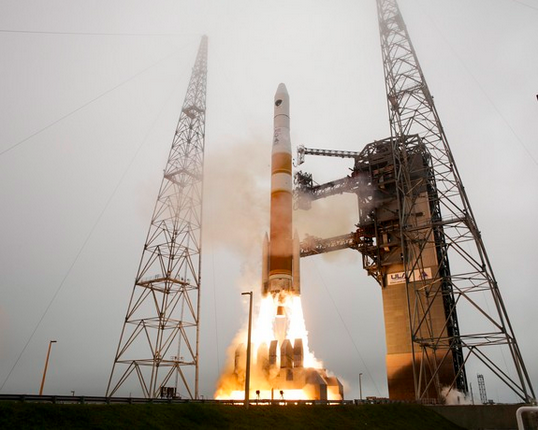Four Satellites Added Across Three Constellations
 Over a span of four days at the end of March, the United States, Europe and India each launched satellites into their respective constellations. On March 25, a Block IIF satellite was launched from Florida’s Cape Canaveral Air Force Station into the GPS constellation. On March 27, two full-operational capable (FOC) Galileo satellites were launched on the same booster from the spaceport in French Guiana and on March 28, a satellite bound for geosynchronous orbit was launched from the Satish Dhawan Space Centre on Sriharikota island (southeast coast of India) as part of the Indian Regional Navigational Satellite System (IRNSS).
Over a span of four days at the end of March, the United States, Europe and India each launched satellites into their respective constellations. On March 25, a Block IIF satellite was launched from Florida’s Cape Canaveral Air Force Station into the GPS constellation. On March 27, two full-operational capable (FOC) Galileo satellites were launched on the same booster from the spaceport in French Guiana and on March 28, a satellite bound for geosynchronous orbit was launched from the Satish Dhawan Space Centre on Sriharikota island (southeast coast of India) as part of the Indian Regional Navigational Satellite System (IRNSS).
The GPS Block IIF satellite will broadcast the legacy P(Y) code signals on L1 and L2 along with the C/A-code on L1. In addition, it will broadcast the military M-code on both L1 and L2, the modernized L2C code on L2 and the civilian signal on L5. This new satellite brings the total number of Block IIFs in the constellation to 9. More information can be found in an article by Mike Wall at Space.com.
As reported by GPS World, the two Galileo satellites were launched on a Soyuz rocket. The two Galileo satellites are the third and fourth FOC satellites but are the first two launched into the proper orbits. Two FOC satellites were launched in August 2014 but a booster failure prevented the satellites from being placed into their intended orbits. The orbits were adjusted to move them out of the Van Allen radiation belt but the satellites did not carry enough fuel to move them into their intended orbits.
The IRNSS satellite is the fourth satellite launched into the Indian constellation. The full constellation will consist of seven satellites: three geostationary satellites (at 34, 83 and 132 degrees East) and two pairs of geosynchronous satellites (one pair at 55 degrees East and the other pair at 111.75 degrees East). The first two IRNSS satellites populated the 55 degree slot and the third satellite occupies the 83 degree geostationary position. The new satellite is the first satellite in the 111.75 degree slot. More information is available from an article by William Graham at nasaspaceflight.com.
With just a handful of launches per year, it takes a number of years to populate (or re-populate) a given constellation. While waiting, researchers can simulate full constellations with software tools such as the SatNav Toolbox for MATLAB by GPSoft.
